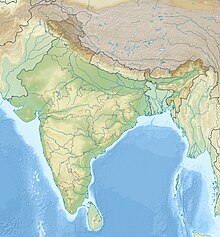This article should specify the language of its non-English content, using {{lang}}, {{transliteration}} for transliterated languages, and {{IPA}} for phonetic transcriptions, with an appropriate ISO 639 code. Wikipedia's multilingual support templates may also be used. (December 2021) |
| Udayagiri and Khandagiri Caves | |
|---|---|
| Kattaka Caves | |
 Udayagiri caves | |
| Location | 3 kms south of Bhubaneswar in Odisha, India |
| Coordinates | 20°15′46″N 85°47′10″E / 20.2628312°N 85.7860297°E |
| Part of a series on |
| Jainism |
|---|
 |
Udayagiri and Khandagiri caves, formerly called Kattaka Gumpha or Cuttack caves, are partly natural and partly artificial caves of archaeological, historical and religious importance 3 kms south of the city of Bhubaneswar in Odisha, India. The caves are situated on two adjacent hills, Udayagiri and Khandagiri mentioned as Kumari Parvata in the Hathigumpha inscription.[1] They have a number of finely and ornately carved caves built during the 1st century BCE.[2][3] It is believed that most of these caves were carved out as residential blocks for Jain monks during the reign of King Kharavela.[4] Udayagiri means "Sunrise Hill" and has 18 caves while Khandagiri has 15 caves.[5]
The caves of Udayagiri and Khandagiri, called lena or leṇa in the inscriptions, these were taken out mostly during the reign of Kharavela for the abode of Jain ascetics. The most importance of this group was Ranigumpha in Udayagiri which is a double storeyed monastery. Other important caves include Hathi Gumpha, Ananta Gumpha, Ganesha Gumpha, Jaya Vijaya Gumpha, Mancapuri Gumpha, Bagha/Byaghra/Vyaghra Gumpha and Sarpa Gumpha.[6]
The Archaeological Survey of India (ASI) has listed that Udayagiri and Khandagiri Caves in the list of "Must See" Indian Heritage.[3]
The Udayagiri and Khandagiri Caves are listed as one of the Adarsh Smarak Monument by ASI.[7]
- ^ Shah 1995, p. 30.
- ^ Michell 1990, pp. 238–240.
- ^ a b "Udayagiri and Khandagiri Caves, Bhubaneswar, Khurda, Odisha". "Must See" Indian Heritage. Archaeological Survey of India.
- ^ Krishan & Tadikonda 1996, p. 23.
- ^ Pandya 2014, p. 6.
- ^ Kapoor 2002, p. 375.
- ^ "Adarsh Smarak Monument". Archaeological Survey of India. Retrieved 2 May 2022.

